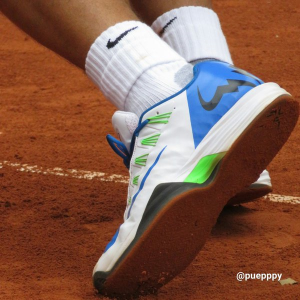 (Photo by @puepppy.)
(Photo by @puepppy.)
Please click here to see the revised and updated version of this article published in 2019.
In April, professional tennis players change their shoes.
Gone are the standard smooth “tennies” designed for comfort on hard courts. In their place are textured soles optimized for traction on loose, red powder.
A whirlwind of travel that carries players through the summer heat of Australia, South America, and the tropics and sets them down in March on the hard courts of North America, delivers them in April to the European “red dirt.” There they contest a series of clay court tournaments that culminates in the French Open.
Over the next six weeks, in eight different countries, players will be tested in what many fans believe to be the purest form of tennis — where the surface gives no advantage to raw power, where players must be proficient at every aspect of the game (serve, return, groundstrokes, volleys, and defense), and where players face the greatest physical and mental demands of the year.
What is the “clay”?
The “clay” in a modern clay court is typically crushed brick layered upon a gravel base to improve drainage. The court’s top layer is a fine red powder.
Much as an ice rink is smoothed periodically by a Zamboni, a clay court is swept to rid the surface of footprints, skid marks, gouges, and ball marks. Usually, a clay court is swept after every set and sprayed with water as needed to prevent the top surface dust from blowing.
What makes clay court tennis special?
The key characteristics of a clay court, from a player’s perspective:
- It is slippery.
Movement on a clay court is night-and-day different from movement on the hard courts on which professionals spend most of the year. Stopping, starting, and changing direction are all made more difficult by the court’s dusty top layer. Balance becomes especially critical.
The slipperiness affects tactics (for example, it’s especially profitable on clay to aim a shot behind a moving opponent) and profoundly affects a player’s timing. The most adept claycourters learn to slide into their shots.
- The ball’s bounce is high.
Clay rewards players who put heavy topspin (i.e., forward spin) onto a ball by giving topspin shots a high bounce. (By contrast, on grass courts and many indoor hard courts, top-spinning balls tend to say low.)
The high bounce can throw off an opponent’s timing and/or place the ball above an his optimal “strike zone,” in either case making it difficult for an opponent to hit the ball with power and accuracy.
- The ball always leaves a mark on the court surface.
At clay tournaments, players cannot ask for computerized “Hawkeye” challenges, because every shot leaves a mark. Instead, players can summon umpires out of their chairs to check ball marks.
Or, in rare cases, compel a cameraman to photograph a mark.
- The surface is “slow.”
As the ball strikes the court surface, the clay holds it briefly during the bounce, giving an opponent an extra fraction of a second to reach the ball. (By contrast, grass courts and many hard courts are “fast.”)
Consequently, it is much more difficult on clay than on a hard court for a player to hit a winning shot past his opponent. Rallies are long, and matches are both physically and mentally arduous on clay.
Clay rewards players who have good defensive skills (i.e., the ability to run down opponents’ shots and keep a ball in play). Some of the tour’s most proficient claycourters, including Rafael Nadal, Novak Djokovic, and David Ferrer, excel at forcing their opponents to “hit one extra shot” and eventually miss.
Defense alone, though, is not sufficient to guarantee wins. Those who succeed on clay know when and how to hit an aggressive shot that either takes control of a rally or wins a point outright.
Clay rewards decision-making, shot-selection, problem-solving, patience, and the vanishing art of point construction — the chess match wherein each player tries to think several shots ahead and outmaneuver his opponent to make space on the court for a winning shot.
Executed well, clay court tennis offers both breathtaking athleticism and fascinating drama.
The Spring European Clay Court Season
The marquee event of the clay court season is the French Open, the calendar year’s second Grand Slam tournament, held at Roland Garros in Paris. To ensure that players reach Roland Garros in optimal clay court form, the tennis tour devotes six weeks to warm-up tournaments in Europe.
Week 1: Monte Carlo
Leading off the series is the Monte Carlo Rolex Masters tournament. First played in 1897, this “Masters 1000” event (one tier below the Grand Slams) offers fans and players alike the most beautiful setting of the season.
The 2016 event, which begins on April 10, boasts the strongest field in years, with seven of the world’s top eight players and a bumper crop of highly talented youngsters playing. There are no easy matches. Nearly every player faces a tough slate of potential opponents.
The defending champion is World #1 Novak Djokovic of Serbia, who has won the event twice in the last three years.
Rafael Nadal won eight consecutive titles in Monte Carlo, from 2005 through 2012. His record might never be equaled.
Update: Rafael Nadal def. Gael Monfils 7-5 5-7 6-0 to win the title in Monte Carlo.
Click here for Five Quick Thoughts about the Monte Carlo Rolex Masters.
Week 2: Barcelona and Bucharest
During the week of April 18, some lower ranked players who did not qualify for the Monte Carlo tournament will begin their French Open preparations at a smaller “250” event Bucharest. Most of the top players will either sit the week out or travel to a medium-sized “500” event in Barcelona.
Because Barcelona’s Open BancSabadell serves as the Spanish national championship, nearly every healthy Spanish player is in the field. Thirty-four-year-old Spaniard David Ferrer has said that winning the Barcelona title would mean as much to him as winning a Grand Slam.
Fourteen of the last 20 Barcelona champions have been Spanish, including eleven straight from 2003 to 2013 (and Rafael Nadal eight times between 2005 and 2013), but the player to hoist the tournament’s enormous trophy in the last two years has been the scrappy Japanese baseliner Kei Nishikori.
Update: Rafael Nadal def. Kei Nishikori 6-4 7-5 to win his ninth title in Barcelona.
Fernando Verdasco def. Lucas Pouille 6-3 6-2 to win the title in Bucharest.
Week 3: Istanbul, Munich, and Estoril
In the week of April 25, mid-level and lower ranked players will hone their clay court skills at three small 250-level tournaments in Istanbul, Munich, and Estoril, while most of the Top-20 players take a breather before back-to-back Masters 1000 events in Madrid and Rome.
Update:
Philipp Kohlschreiber won a barn-burner of a final over Dominic Thiem, 7-6(7) 4-6 7-6(4), to take the title in Munich.
Diego Sebastian Schwartzman upset Grigor Dimitrov 6-7(5) 7-6(4) 6-0 in Istanbul to win the first title of his career.
Nicolas Almagro outlasted his countryman Pablo Carreno Busta 6-7(6) 7-6(5) 6-3 to take the title in Estoril.
Week 4: Madrid
Since the early 2000s, the lead-up to the French Open has included three Masters 1000 tournaments. Two of those three are the events in Monte Carlo and Rome. Until 2008, the third Masters 1000 on clay was held in Hamburg. Because of Hamburg’s inclement weather (and, most likely, some behind-the-scenes politics), the third clay Masters 1000 was moved to Madrid in 2009.
The Madrid tournament poses a unique challenge during the pre-Roland Garros swing: high altitude. The ball travels faster through the air in Madrid than at the sea-level events, and Madrid’s relatively dry air makes the court both faster and more slippery.
As a joint men’s and women’s event with limited court space, the Madrid tournament is known for its long days. Often matches start after 11 p.m.
Nearly every year of the Madrid clay event’s young life has brought intense drama.
- In the inaugural event in 2009, Rafael Nadal and Novak Djokovic played a four-hour-and-three-minute semifinal, which is the longest best-of-three-set match in the Open Era of men’s tennis. Nadal won the match but had nothing left for the next day’s final. The psychological blow of losing that marathon may have contributed to Djokovic’s loss in the third round of that year’s French Open. The physical wear-and-tear surely contributed to the knee problems that led to Nadal’s fourth-round loss at the French and his subsequent two-month absence from the tour.
- In 2011, Djokovic surprised Nadal and angered the home crowd by carrying out some decidedly in-your-face celebrations after beating Nadal in the final, including (by some accounts) a swim in a nearby canal and noisy dancing with his team on top of a parked car.
- In 2012, the tournament replace the red clay with blue clay. Although the blue clay showed up better on television, it might have been catastrophic for the players, because it was extremely slippery. Players who typically remain centered over their feet, such as Roger Federer and David Ferrer, were relatively unaffected. For Nadal and Djokovic, who tend to hit more off-balance defensive shots, the conditions were potentially lethal. After 2012, the tournament switched back to red clay.
- In 2013, a crowd still angry at Djokovic for his behavior in 2011 gave him a hard time during his loss to Grigor Dimitrov. Djokovic, who has never had patience with hostile crowds, and who often behaves as though every crowd owes him affection, screamed at his hecklers in Serbian, “You can lick my ____, and I can ____ your mothers!”
Djokovic has not played in Madrid since 2013. This year he will return. It will be interesting to see how he gets along with the assertive and opinionated Madrid fans.
The event’s defending champion is Andy Murray. Nadal has won the Madrid event on clay three times.
Update: Novak Djokovic def. Andy Murray 6-2 3-6 6-3 to win the title in Madrid.
Click here to read Four Lessons from the 2016 Mutua Madrid Open.
Week 5: Rome
The week after Madrid takes the players back to sea level at the Intenationali BNL d’Italia in Rome, first played in 1930. The tournament grounds feature a steeply raked stadium surrounded by statues in a classical style, located atop the site of the swimming venue of the 1960 summer Olympics.
Djokovic comes into this year’s Rome event as the two-time defending champion, having won the title four times in the last six years. Nadal holds the record for Rome titles with seven.
Update: Andy Murray def. Novak Djokovic 6-3 6-3 in the Rome final to win his third clay title and his second at the Masters 1000 level.
Week 6: Nice and Geneva
The last week before the French Open will find most of the top-ranked players in Paris practicing at Roland Garros, speaking to the media, and appearing at sponsor events. Meanwhile, 250-level events in Nice and Geneva offer final tune-up opportunities for late-arriving journeymen players as well as a few hometown stars.
Update:
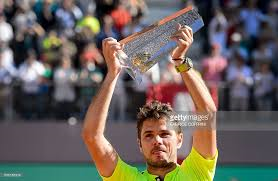
Stan Wawrinka def. Marin Cilic 6-4 7-6(11) to win his second consecutive Geneva title and his third title of 2016.
Like Wawrinka, Dominic Thiem defended his 2015 title and earned his third trophy of 2016 by defeating fellow rising star Alexander Zverev 6-4 3-6 6-0 in Nice.
Weeks 7 and 8: The French Open, Roland Garros, Paris
On 22 May, 128 men will begin the quest for the year’s second Grand Slam singles title at the French Open at Roland Garros. Fifteen days later, one man will hoist aloft the tournament’s storied trophy, the Coupe des Mousquetaires.
Because Roland Garros is the only Slam site with no lighting for night matches, and since clay matches tend to be long, the French Open is the only Slam whose first match is held on a Sunday.
Every Grand Slam tournament offers compelling drama from the start. It is fascinating to watch players ranked 70 or 80 in the world, with no hope of winning the title, battle tooth-and-nail for the right to advance to the next round. Every day of the first week promises valor, heart, and sportsmanship.
One of my favorite tales of Roland Garros valor took place in 2013 and starred thirty-one-year-old Spaniard Tommy Robredo. Known as a tenacious fighter, and expert like many of his countrymen in the art of tennis on clay, Robredo outdid himself by coming back from two-sets-to-none deficits to win five-set matches in three consecutive rounds, a feat unmatched in the previous 86 years. After his third comeback, Robredo collapsed the court in tears as the stadium crowd chanted his name.
More drama, of the “never-a-dull-moment” variety, erupted later in the same event, when flare-wielding political protestors crashed the men’s final between Nadal and Ferrer, spooking both contestants.
In addition to the French crowd’s perennial hope for a homegrown champion, the intrigue at Roland Garros 2016 — whose field is more open than it has been in years — features a cast of terrific clay court players all of whom have fascinating storylines.
The Contenders
It is highly probable that the man left holding the Coupe de Mousquetaires this year will be one of a short list of “usual suspects.”
The King of Clay – Rafael Nadal
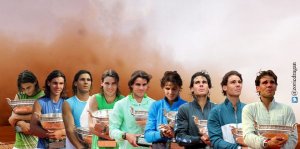 Photo by @zoricdragan.
Photo by @zoricdragan.
Twenty-nine-year-old Spaniard Rafael Nadal is the greatest clay court player in the history of tennis.
- He leads all men in the Open Era with a staggering 91.6 match winning percentage on clay.
- He is in second place in the Open Era with 47 titles on clay.
- He won a record 81 consecutive matches on clay from 2006 to 2008.
- He won in excess of 50 consecutive semifinal matches on clay from 2008 to 2015.
Several attributes of Nadal’s highly individualistic style are especially well suited to the red dirt.
- The unmatched topspin he applies to his shots, especially to his forehand with the distinctive “lariat” follow-through.
- Excellent, precise footwork.
- A deep understanding of the game and of point construction.
- Formidable problem-solving skills.
- Great competitive intensity that wears down many opponents as Nadal plays every point as though it were his last.
Nadal has won eight Monte Carlos, eight Barcelonas, three Madrid titles on clay (and one when the tournament was played on an indoor hard court), seven Romes, and nine French Opens.
That’s nine titles at the most physically and mentally demanding Major tournament.
No one else has ever won as many as eight titles at a single Slam.
Nadal is no slouch on surfaces other than clay. He owns four titles, including two Wimbledons, on grass (which, fast and low-bouncing, is essentially the opposite of clay). On hardcourts, he has sixteen titles, include two US Opens and one Australian Open.
Nadal’s career has been a series of injury outages followed by comebacks.
- In 2005, six months after winning his first French Open, Nadal broke a bone in his left foot (later found to have been congenitally deformed) and was reduced to hitting balls while seated in a desk chair.
In 2006, he returned to the tour, won his second French Open, and reached his first of five consecutive Wimbledon finals.
- In 2007 and 2008, the arch supports he was required to wear to protect his vulnerable foot started to wreak havoc on his knees. In 2009, knee pain forced to stop competing for two months and miss Wimbledon.
In 2010, in a spectacular run that started in Monte Carlo, Nadal won seven titles, including the French Open, Wimbledon, and the US Open, in the process becoming the first and only male player in the history of the sport to win three Slams on three different surfaces in the same year.
- In 2012, severe knee tendonitis forced Nadal off of the tour again, causing him to miss the second half of the season, including the London Olympics.
In 2013, Nadal returned from a seven-month absence to win ten titles, including the French Open and the US Open, and finished the year at #1 – this in spite of his having missed the Australian Open entirely.
In 2014, Nadal suffered three apparently random physical failures: the first, a back injury that befell him in the middle of the Australian Open final in February; the second, a freak wrist injury in August that forced him to miss the US summer hard courts and the US Open; the third, in October — four days after he had returned to competition — acute appendicitis.
In 2015, Nadal experienced what he describes as a “mental injury.” For the first half of the year, he suffered crippling anxiety on court. He was unable to control his breathing or his emotions. He was, as he recently described it, “competing against himself.” During that stretch, Nadal delivered several truly baffling performances — including at Barcelona, Madrid, Rome, Roland Garros, and later Wimbledon — in which he seemed unable to make decisions and could not hit accurate shots to save his life.
Through what he describes as “daily hard work,” Nadal was able to gradually rid himself of the anxiety. He told the press in October that those bad feelings had gone away.
Because he is what some coaches call a “confidence player,” Nadal faces a maddening chicken-and-egg problem during his every comeback:
To win matches, he needs the confidence to go for big shots on important points.
To have confidence, he needs to win matches.
Last month, in Indian Wells in the desert of southern California, Nadal seemed at long last to have turned the corner. He had four good wins over difficult opponents and then played his best match against Djokovic in nearly two years.
Nadal said in a recent interview that, unlike last year, he now enjoys practices and matches, and he feels ready to compete with anyone.
In 2016, Nadal is fit, healthy, and happy as he returns to his favorite surface and to events where he has enjoyed great success in the past.
(Memo to his would-be opponents: watch out.)
The Reigning King of the Tour – Novak Djokovic
One year Nadal’s junior, Serbia’s Novak Djokovic won his first Grand Slam title (in Australia) in 2009. After floating in the Top 4 for four years, Djokovic came into his own in 2011, winning the Australian Open, Wimbledon, and the US Open, and finishing the year at #1 for the first time.
Beginning in 2012, Djokovic opened each year by telling the press in January of his desire (or intention) to win the year’s French Open, and thereby complete his Career Grand Slam (which Federer had achieved in 2009 at age 27 and Nadal in 2010 at age 24).
In 2012, Djokovic reached the Roland Garros final and lost to Nadal.
In 2013, Djokovic lost to Nadal in a semifinal — a virtuosic five-set masterpiece that has been called the greatest match ever played on clay.
In 2014, Djokovic again reached the final at Roland Garros and again lost to Nadal.
Last year, with Nadal floundering, promised to be Djokovic’s golden opportunity. Reversing his Roland Garros script, Djokovic dispatched his usual nemesis by trouncing him efficiently in a quarterfinal.
On the morning of the final, only the Swiss Stan Wawrinka stood between Djokovic and his Career Grand Slam. After Djokovic won the first set, he seemed well on the way to achieving his much-talked-about dream.
Then Wawrinka delivered the three best sets of tennis he has played in his life, a breathtaking display of power and precision. Pounding the ball off of both wings, Wawrinka kept Djokovic on the run. Wawrinka controlled most of the rallies with bludgeoned groundstrokes and hit winner after blistering winner.
When it was over, and Djokovic stood on the podium once again holding the runner-up plate, he received a lengthy standing ovation from a crowd sympathetic to his plight.
During the balance of 2015, Djokovic lost only two matches, both of them finals.
Djokovic enters the 2016 European clay court season having won all of his completed matches this year (his only loss was a retirement), but he has shown some uncharacteristic vulnerability.
At the Australian Open, Frenchman Gilles Simon employed persistent defense to drive Djokovic to distraction, force Djokovic to five sets, and draw more than 90 unforced errors from the Serb’s racquet.
In Indian Wells, Djokovic lost a set to World #165 Bjorn Fratangelo and later against Nadal commited a striking number of errors with his best shot, the return of serve.
In Miami, Austrian Dominic Thiem was able to create a passel of break point opportunities against Djokovic but could not cash them in. In the next round, Belgian David Goffin broke Djokovic several times but was unable to maintain any advantage.
It is possible that Djokovic will “run the table” on the European clay. He might this year finally win the French Open.
Or he might lose a few points at important moments and find himself on the unfamiliar losing end of a match.
Djokovic will be the oddsmakers’ favorite at every event he plays from now through Roland Garros, but he is not a shoo-in.
Federer
When 34-year-old tennis superstar Roger Federer published his 2016 tournament schedule, his European clay court season was rather thin. Focusing on tournaments more likely to enhance his legacy (specifically, Wimbledon and the Rio Olympics), Federer had opted to minimize his work on clay.
Then in early February, Federer’s plans were upended by a turn of events new in his experience: an injury that required surgery. Having been forced to sit out for two months, Federer decided recently to refocus on the clay events, beginning with Monte Carlo. This renders the tournaments both more interesting for fans and more lucrative for tournament sponsors.
Although he might have lost with age a bit of speed and consistency, Federer is still the most graceful player ever to pick up a tennis racquet. With his lethal serve and time-robbing aggression, Federer can still consistently beat 80 to 85 percent of the players on the tour.
Federer’s playing style is best suited to faster, low-bouncing surfaces (to wit, grass and indoor hard courts at sea level). Winning a clay tournament at the Masters 1000 or Grand Slam level is a tough task for him. That said, if breaks were to fall the right way, anything could happen.
Federer, like Nadal, has shown repeatedly that one is unwise ever to write him off.
The Reigning French Open Champion – Stan Wawrinka
Switzerland’s Stan Wawrinka owns two Grand Slam titles: the 2014 Australian Open and the 2015 French Open. Physically strong, and blessed with a one-handed backhand as lethal as it is beautiful to watch, Wawrinka at his best can beat anyone on the tour.
Wawrinka is also wildly inconsistent. In 2014, the year of his first Grand Slam and also his first Masters 1000 title (in Monte Carlo), Wawrinka lost nine times in a tournament’s first round, including a straight-sets loss in the first round of Roland Garros.
In the following year, Wawrinka played brilliantly at Roland Garros, beat both Federer and Djokovic, and won the title.
It can be difficult to predict on any given day which Wawrinka will show up on court. Realistically, he could lose early in two or three events on the European clay. With equal probability, he might win three or four of the titles.
Any Wawrinka match is worth watching for the quality of his tennis and for the likelihood of on-court drama.
The Intrepid Fighter – David Ferrer
Thirty-four-year-old Spaniard David Ferrer is known and respected on the tennis tour for his dogged determination and indefatigability.
Although at 5’9″ Ferrer might be too small to win a Grand Slam during this Golden Age of men’s tennis, experts and commentators agree that in a different era Ferrer would have won at least one Slam and probably a French Open.
With 26 titles, Ferrer is the most highly decorated male player in the Open Era never to have won a Slam. Like many of his countrymen, Ferrer excels on clay, having won 12 of his titles on the red dirt. Ferrer has reached the semifinals on clay in Madrid, the final in Barcelona, the final in Monte Carlo, and the final in Rome. In 2013, he reached the final at Roland Garros, where he lost to Nadal.
Although Ferrer might have slowed down somewhat with age, his disciplined point construction, tenacious defense, and outstanding return of serve can still carry him to victory over most players on clay, especially in a best-of-five-set format.
Ferrer may appear to be an outlier among these Contenders, since he has not yet won a title on the European clay, but I believe he belongs on this short list because in his trophy cabinet at home he has hardware from Roland Garros.
Only five active male players have contested a French Open final.
- Nadal (2005 – 08, 2010 – 14)
- Federer (2006 – 09, 2011)
- Djokovic (2012, 2014, 2015)
- Wawrinka (2015)
- Ferrer (2013)
The Second Tier
Among the remaining 123 men who will contest the singles competition in Paris, at least 15 have the potential to cause upsets within the draw. Some worthy of especial note:
Dominic Thiem
Twenty-two-year-old Austrian Dominic Thiem is almost certainly a future French Open champion. As highly disciplined as he is talented, Thiem possesses a well-rounded game as well as a gorgeous one-handed backhand.
Thiem has won two titles so far this year, including on clay in Buenos Aires, where he beat Nadal in the semifinal. Although Thiem may not be ready to win seven best-of-five-set matches at Roland Garros, he might well be capable of taking a Masters 1000 title in the coming weeks.
Kei Nishikori
With a playing style sometimes described as “Djokovic without the celebrations,” Japan’s Kei Nishikori has established himself solidly among the game’s Top 10. Nishikori’s easy power and precise ball striking can carry him past any player. In recent years, he has notched wins over Nadal, Federer, and Djokovic.
Two of Nishikori’s eleven titles have come on clay, both in Barcelona. If he stays healthy, which is always the biggest question with Nishikori, he could be a threat at any of the European clay events.
Gilles Simon
Like David Ferrer, Frenchman Gilles Simon has turned an unprepossessing physical presence into an asset. Although not endowed with great power, Simon brings to court some of the cleanest and most tenacious defensive skill on the tour. An absolute nightmare of a match-up in a best-of-five format, Simon could give the home fans reason to cheer into the second week at Roland Garros.
Roberto Bautista Agut
With two titles already this year, 27-year-old Roberto Bautista Agut is the most successful Spanish player through the first quarter of 2016. In his short career on tour, he has won four titles, including one each on clay and grass.
Bautista Agut’s clean, well-rounded game is probably not strong enough to carry him to the trophy stand at any of the spring’s clay events, but he could serve as a spoiler.
Jo-Wilfried Tsonga
As a player, 30-year-old Frenchman Jo-Wilfried Tsonga is a bit of an enigma.
Sometimes he channels his prodigious talent and athletic ability into an aggressive, powerful game that defeats all comers. He has beaten Federer twice in Grand Slams, including once at the French Open.
At other times — such as his 2013 dismantling by Ferrer one round after his victory over Federer at Roland Garros — Tsonga looks disoriented and defeated well before the end of the first set.
A subject of Roland Garros scrutiny and pressure every year as a top French prospect, Tsonga truly has a game that would enable him to win.
Whether he hoists any trophies this spring, or pulls off any important upsets, or bows his head in defeat, will depend upon which Tsonga shows up to play.
So who will win?
I don’t make predictions. 🙂
Update: Novak Djokovic def. Andy Murray 3-6 6-1 6-2 6-4 to win his first French Open title and complete his career Grand Slam.
Quote for Today
“If” doesn’t exist in sport. That’s the real thing. If, if, if – never comes. The thing is, you have to do it. – Rafael Nadal

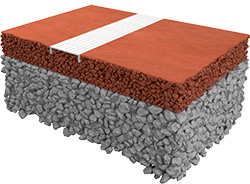
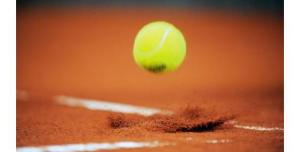
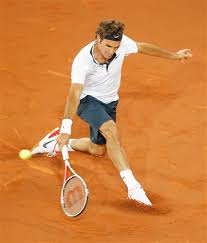
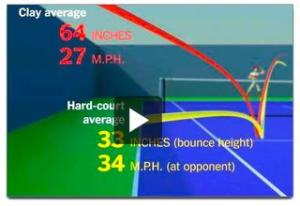
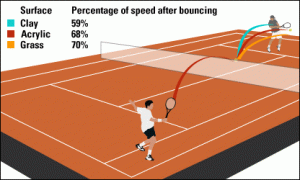
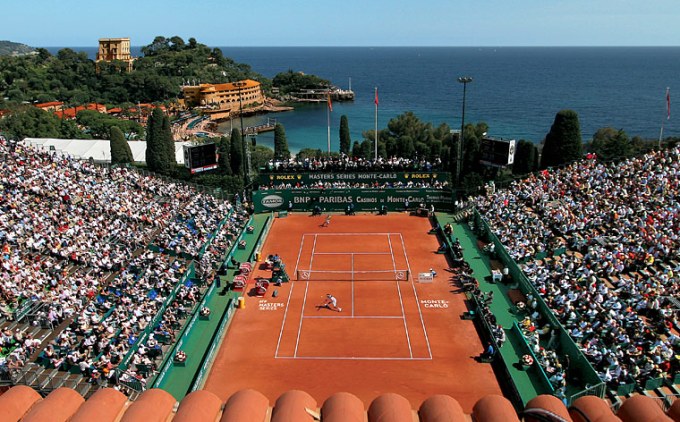
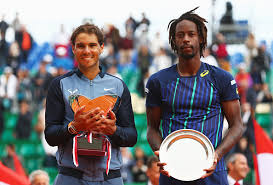
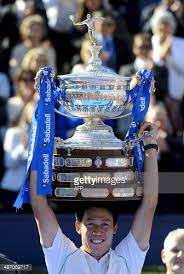
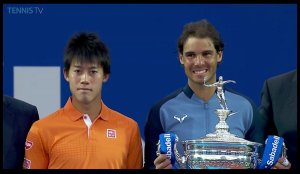
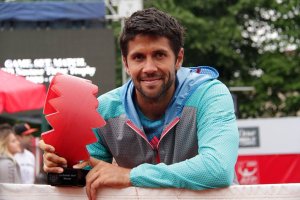
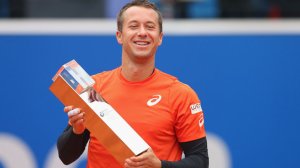
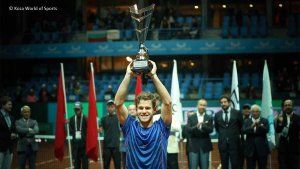
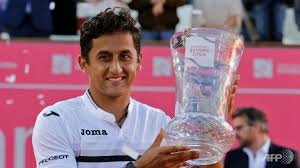

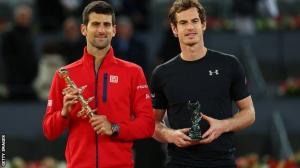
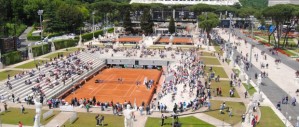
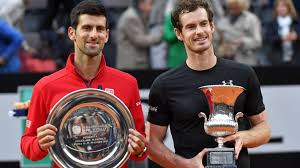
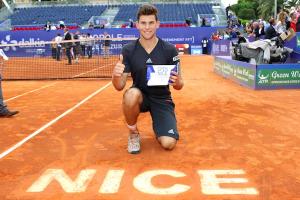
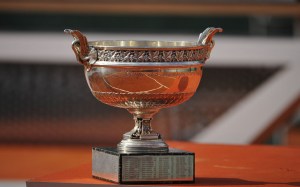
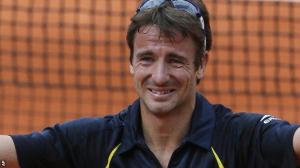
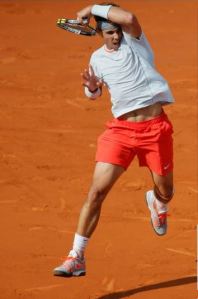
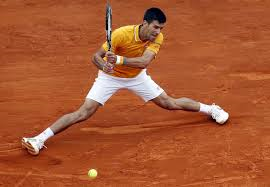
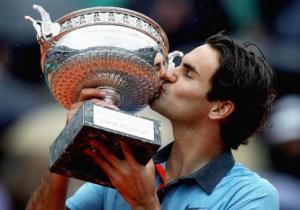
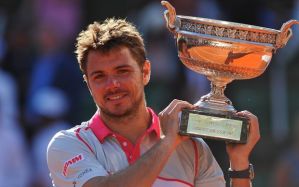
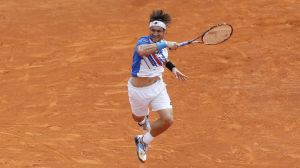
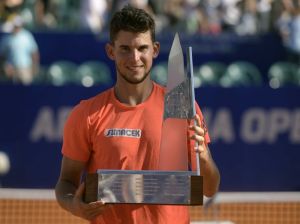
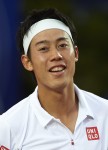
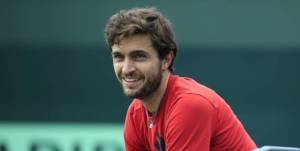
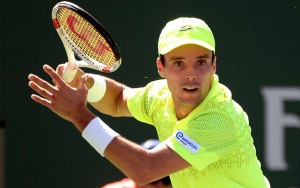
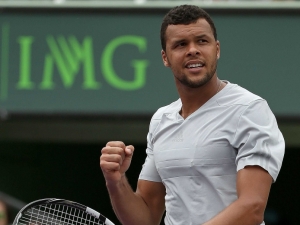
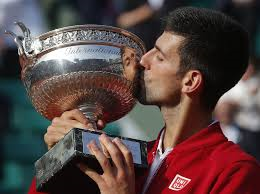
You can tell the writer is a Nadal fan who dislikes Djokovic. The biases seep in which really damage the article
LikeLike
Please feel free to correct any factual points that you believe were inaccurate.
LikeLiked by 1 person
Comprehensive and wonderful info. Thank you Cynthia. Marie
>
LikeLiked by 1 person
So glad you enjoyed it, Marie! Thank you.
LikeLike
really well done piece. very informative. thanks for explaining a lot of this stuff. even a big tennis fan like myself didn’t know some of it.
LikeLiked by 1 person
Thank you.
LikeLike
An excellent summary of the season, the players, the protocols, and partners! Thank you for sharing your wealth of info, and for collating it so purposefully to serve as a great resource to novices and seasoned followers of the sport, alike.
On Sun, Apr 10, 2016 at 5:52 PM, Northwoods Listener wrote:
> Cynthia Tanner posted: ” (Photo by @puepppy.) In April, professional > tennis players change their shoes. Gone are the standard smooth “tennies” > designed for comfort on hard courts. In their place are textured > soles optimized for traction on loose, red powder. A whirlwin” >
LikeLike
I’m glad you enjoyed the post, Simmi. It was great fun to write.
LikeLike
FANTASTIC piece Cynthia!! I’ve just discovered your website after following a question you had posted for Brad Gilbert via espn.com. I’ve gotten even more fanatical in my passion for professional tennis over the last 3 months. This article was one of the best I’ve ever read with it’s insight on the intricacies of clay court competition and the overview of the clay court season and standout players. Keep up the great work and we’ll keep reading!
LikeLiked by 1 person
Thank you very much.
LikeLike